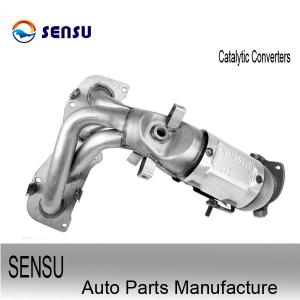
Add to Cart
Universal Auto Exhaust Parts Automobile Catalytic Converter for BMW
About the Item
High Performance Universial Car Catalytic Converters Racing Car Catalytic Converters
Brief Introduction:
| ►Function: | to reduce the toxicity of emissions from an internal combustion engine |
| ►Working Principle: | Reduction of nitrogen oxides to nitrogen and oxygen: 2NOx → xO2 + N2 Oxidation of carbon monoxide to carbon dioxide: 2CO + O2 → 2CO2 Oxidation of un-burnt hydrocarbons (HC) to carbon dioxide and water: CxH2x+2 + [(3x+1)/2]O2 → xCO2 + (x+1)H2O |
Quick Description List:
| ►Body Material | stainless steel 304/409 |
| ►Welding | Excellent welding process |
| ►Type | Catalytic Converter |
| ►Size | 4.8" x 10" x 14" |
| ►Car Model | Universal |
| ►Emission Standard | EPA,CARB |
| ►Port of Loading | Xingang, China |
| ►Delivery Time | 5-30 Days |
| ►Payment Term | 30% |
| ►Warranty | 1 year , under the warranty, if any quality problem, we'll supply again by free. |
Universal Auto Exhaust Parts Automobile Catalytic Converter for BMW:
Although catalytic converters are most commonly applied to exhaust systems in automobiles, they are also used on electrical generators, forklifts, mining equipment, trucks, buses, locomotives, and motorcycles. They are also used on some wood stoves to control emissions.[5] This is usually in response to government regulation, either through direct environmental regulation or through health and safety regulations.
Catalytic converters require a temperature of 800 degrees Fahrenheit (426 °C) to efficiently convert harmful exhaust gases into inert gases, such as carbon dioxide and water vapor. Therefore, they are placed as close to the engine as possible.
Universal Auto Exhaust Parts Automobile Catalytic Converter for BMW Pics


Application:
Although catalytic converters are most commonly applied to exhaust systems in automobiles, they are also used on electrical generators, forklifts, mining equipment, trucks, buses, locomotives, and motorcycles. They are also used on some wood stoves to control emissions.[5] This is usually in response to government regulation, either through direct environmental regulation or through health and safety regulations.
Catalytic converters require a temperature of 800 degrees Fahrenheit (426 °C) to efficiently convert harmful exhaust gases into inert gases, such as carbon dioxide and water vapor. Therefore, they are placed as close to the engine as possible.